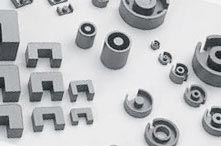What are Ferrite Core Transformers?
Ferrite core transformers are made from ferrite materials. The ferrite core transformer is used for higher-frequency applications. The power transformer is made out of CRGO steel core, which operates at 50 or 60 Hz frequency.

The transformer operating at a higher frequency is designed with a ferrite core. At high frequencies, a ferrite core transformer exhibits high magnetic permeability and low electrical conductivity, enabling efficient magnetic flux transfer while significantly reducing eddy current losses. The composition of the ferrite core in a transformer is iron oxides((Fe2O3) combined with oxides of nickel, zinc, and manganese compounds. These compounds have low coercivity and are also called soft ferrites.
Advantages of Ferrite Core Transformer?
A major advantage of a ferrite core is its high electrical resistance to high current—the high resistance to eddy current leads to lower eddy current losses over a wide range of frequencies.
Ferrites have an advantage over other types of magnetic materials due to their high electrical resistivity and low eddy current losses over a wide frequency range. These characteristics, along with high permeability, make ferrite ideal for use in applications such as high-frequency transformers, wide-band transformers, adjustable inductors, and other high-frequency circuitry from 10 kHz to 50 MHz.
Its high permeability adds to its ideal combination for use in high-frequency transformers and adjustable inductors. In fact, the high magnetic permeability, along with the low electrical conductivity of ferrites, helps prevent eddy currents, and thus, eddy current losses decrease. A lack of eddy currents and consistent performance at high frequencies makes these cores ideal for RF transformers.
Due to their high efficiency and superior magnetic properties, ferrite core transformers can be designed to be smaller and lighter than iron core transformers. This compact size makes them ideal for modern electronic devices, where space and weight are critical factors.
Ferrite cores exhibit stable magnetic properties over a broad temperature range, providing reliable performance even in changing environmental conditions. This consistency is crucial for industrial and automotive applications where temperature fluctuations are frequent.
Disadvantages of Ferrite Core Transformer
One disadvantage when working with ferrite is its brittleness. Compared to metal cores, this core is more likely to be damaged by drops and bangs. Powder cores are stronger than ceramic cores but weaker than metal.
Ferrite cores have a lower saturation flux density than materials like silicon steel, meaning they reach saturation with less magnetic flux. This limitation can constrain their use in high-power applications that demand higher flux densities.
Although ferrite cores excel at high frequencies, their magnetic permeability decreases at lower frequencies, potentially reducing efficiency and performance in applications that primarily operate at lower frequencies.
While ferrite cores offer good temperature stability, they are more sensitive to temperature variations than some other core materials. This sensitivity can impact their magnetic properties and performance, particularly in environments with extreme temperature fluctuations.
Ferrite core transformers have a higher initial cost than traditional iron core transformers due to the specialized materials and manufacturing processes involved. This can be a drawback for applications with strict budget constraints.
Types of Ferrite Core Transformers
- Manganese Zinc Ferrite (MnZn) – useful for inductors up to 70 MHz
- Nickel Zinc Ferrite (NiZn) – Higher resistivity than MnZn, useful when the frequency range is from 2MHz to MHz in the several hundred and ideal for inductors over 70 MHz
Temperature and permeability play huge roles in ferrite core selection since ferrite materials begin to lose magnetic capabilities under 500 degrees Celsius. Ferrites are also classified by shapes, such as:
- E, I Cores – easy to construct with simple bobbin winding, making them useful for power and telecom inductors, along with broadband, converter, and inverter transformers
- ETD Cores – center post has minimal winding resistance, ideal for power transformers and inductors
- EFD Cores – made with cross-sectional areas, provide utility for compact transformers
- EER Cores – based on a round center post, providing a shorter winding
Applications of Ferrite Core Transformer
The ferrite core transformer is used as a Converter and Inverter Transformer, Differential Mode Inductor, Power Transformer, Pulse Transformer, and Telecom Inductor.
Read Next: